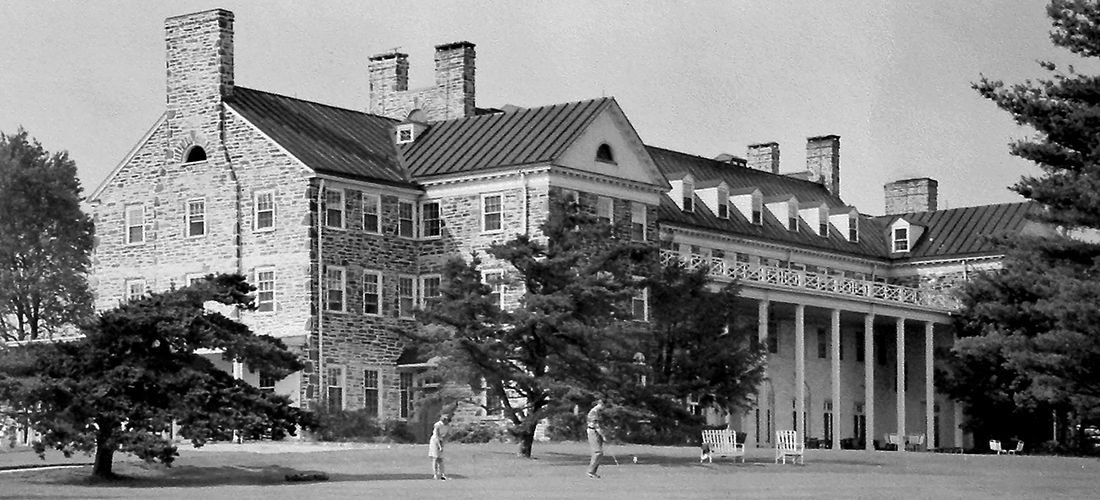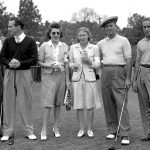
Golf at The Gap
A pure mountain journey
By Lee Pace
Imagine the journey from
Pinehurst to Roaring Gap in the 1920s — 150 miles of two-lane roads west to Candor, north to Asheboro and Winston-Salem, then up Highway 21 into Alleghany County, the last 5 miles replete with steep grades and sharp turns. In the early 1930s, considerable private funds were spent planting rose bushes along the road, ergo the appellation “Road of Roses,” and an early ad for Roaring Gap described the 16-mile passage from Elkin as a “picturesque four-hour drive.”
“My grandfather, my grandmother and their six children all loved going to Roaring Gap once their house was built in the 1920s,” says Jim Gray, a Roaring Gap member into the third generation and native of Winston-Salem. “They would get on a train in Winston-Salem and go west to Elkin, where they spent the night. Then it was up the mountain by horse and buggy — taking a full day. Of course there were cars then, but no decent road up the mountain.”
Today the entrance to the summer residential colony is decidedly understated — a right turn off Highway 21 onto Roaring Gap Drive. I’ve been there twice in my life and both times had to make a U-turn at the gas station half a mile farther north. From there it’s another twisting, winding avenue past the 67-acre Lake Louise on the left and through the deep rhododendrons and oaks until the Donald Ross-designed golf course reveals itself to the left, with the sweeping double fairway of 15 and 16 and the wispy brown grasses on the edges.
“We like to say, ‘If you go downhill, you’ve gone too far,’ referring to the fact there’s no sign to alert you to the entrance,” says director of golf Bill Glenn, who with his late father, Bailey Glenn, has run the golf operation since 1956. “I love how you get a glance at the lake, and then as 15 and 16 come into view for the first sight of golf, it’s like seeing the lights in Vegas. It makes you ready to play.”
Roaring Gap is a direct offspring of Pinehurst, with Leonard Tufts, son of Pinehurst founder James Tufts, partnering in the mid-1920s with the Chatham family of Elkin and several Winston-Salem business magnates with last names like Reynolds, Hanes and Gray to give the winter-oriented Sandhills resort a sister destination for the warm-weather months.
Of course Tufts tapped Ross, who’d conceived and built four golf courses at Pinehurst by 1919, to design the course on a tabletop stretch of 1,200 acres perched at 3,700 feet above sea level. For inspiration for a hotel, Tufts borrowed from George Washington’s Mount Vernon home and constructed the three-story, 65-room Graystone Inn. The community had been named decades earlier for the speed with which the winds whipped through the mountains, and the hotel for the native Blue Ridge masonry used for the exterior.
“What Pinehurst typifies as a winter resort, Roaring Gap will represent in the summer field,” one early newspaper account said. Another added the club was created “to continue the delightful obligations of entertainment for a six months period when Pinehurst relinquishes it in May.” Yet another proclaimed that “Everyone knows the popularity of the Pinehurst hotels, and with Mr. Tufts at the head of this one, makes it a success to start with.”
The golf course and inn opened in 1926, and the layout (measuring just under 6,000 yards at the outset) was billed as “the aristocrat of courses.” The Pinehurst connections were many, from Carolina Hotel manager E.G. Fitzgerald running the Graystone in the summer and Ross’ assistants in Pinehurst, among them Alex Innis, Palmer Maples and Ellis Maples, directing the golf operations at various junctures. There’s even a street named Chinquapin at Roaring Gap, just as there is in the village of Pinehurst.
The Tufts were hustling in the late 1920s, business quite sporty during heady economic times and their Sandhills tentacles expanding to Southern Pines in 1921 with Mid Pines and 1928 with Pine Needles. All of those ventures as well as Roaring Gap took smack downs during the 1930s, though, rendering the original mountain vision null and void in 1932, when Tufts forfeited his interests in the club.
“This ‘Pinehurst legacy’ has gone largely unheralded,” says Roaring Gap member and historian Dunlop White III. “Even today, many Roaring Gap regulars are unfamiliar with the story. I think the fact that the club was formed at the height of Pinehurst’s golden era has always served as the foundation of Roaring Gap’s enduring appeal.”
That endearment remains strong today, for one reason the quality of the vintage Ross design, enhanced with a 2012-14 restoration project directed by White and golf architect Kris Spence, and another the club’s total lack of pretention. The quaint clubhouse from 1939 remains intact, with a modest grill that used to serve Bailey Glenn’s tomato sandwiches — “With peeled tomatoes, that was a detail he insisted on,” says son Bill — and today is proud of its cheeseburger tradition.
“It’s absolutely my favorite place to go and play golf,” says Spence, who began his relationship with the club in the early 2000s. “It’s so laid back and comfortable and relaxed. You go in one screen door and out the other, and right there you’re on the 18th green. The ambience is one-of-a-kind.”
The visuals are unsurpassed, from the view up the fourth fairway to the stately old inn in the background, and from the 17th green, perched on a ledge and looking east toward Pilot Mountain 25 miles away.
The topography requires golfers to plan not only the flight of their shots, but the roll as well. Several fairways are so severely canted that a ball landing on the high side can often roll into the rough on the low side, 40 yards away. The seventh and 11th are par 5s with such dramatic land forms and difficult greens that Ross designed them sans bunkers.
And the greens demand razor-sharp touch and execution, some pins tucked into hillocks in a corner, others rendered nearly inaccessible from the high side. Spence found rounded, “pancake shaped” putting surfaces when he first toured the course, the borders having crept in over time. He and his construction crews peeled the surfaces away, dug below and found the remnants and dimensions of Ross’ original greens. Those have been restored as well as bunkers that got buried or lost their shape. Spence also found several hundred more yards, expanding the course to nearly 6,500 from the black tees.
“I watch people play it year after year, and they always come in and say they’d like another crack at it,” Glenn says. “They think they should have scored better than they did. That’s a pretty magical thing for a golf course to have.”
“Roaring Gap has a great and authentic set of Ross greens, in my opinion,” says Spence. “That whole golf course was laying there, but it was buried under that buildup of many, many years. The wind whipped through there — hence the name ‘Roaring Gap’ — and it blew sand and soil around and the course lost its definition.”
Fortunately in 2017, you can get from the Sandhills to Roaring Gap along some pretty smooth and expansive roads. But it’s still slow going the last 6 miles, making the anticipation all the more intense. PS
Lee Pace has been the golf columnist for PineStraw since 2008 and has recently created a new blog about some of the Carolinas’ top walking golf courses, Roaring Gap among them. Learn more at www.randomgolfwalks.com.





